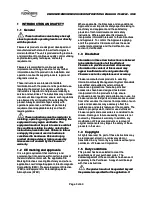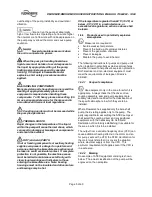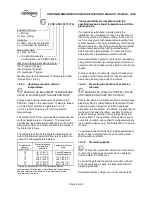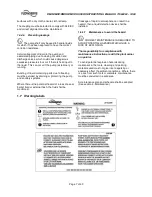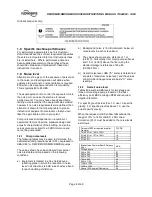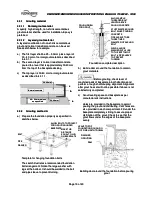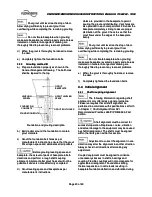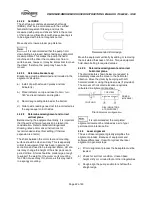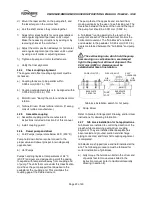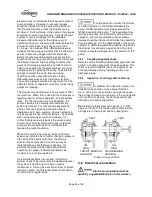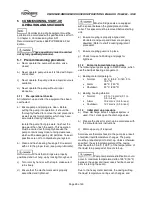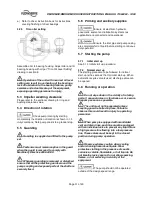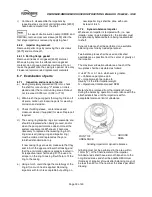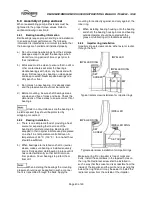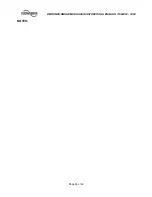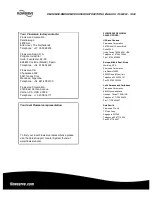
DMX/DMXD/DMXH/DMXDH USER INSTRUCTIONS ENGLISH 71569282 - 10/09
Page 28 of 60
5 COMMISSIONING, START-UP,
OPERATION AND SHUTDOWN
Commissioning of all equipment must be
performed in accordance with specifications set forth
in Chapter 9,
Commissioning
from API
Recommended Practices 686/PIP REIE 686, First
Edition.
These operations must be carried
out by fully qualified personnel.
5.1 Precommissioning procedure
a) Never operate the pump with suction valve
closed.
b) Never operate pump unless it is filled with liquid
and vented.
c) Never operate the pump unless a liquid source is
available.
d) Never operate the pump without proper
lubrication.
5.1.1
Pre-operational checks
At initial start-up and after the equipment has been
overhauled:
a) Ensure pump and piping are clean. Before
putting the pump into operation, it should be
thoroughly flushed to remove the rust preventive
as well as any foreign matter, which may have
accumulated during installation.
Isolate the pump from pipe work, flush out the
pipe work then flush the pump. This operation
must be carried out thoroughly because the
pump contains many close running clearances,
which will be damaged by dirt particles. Take all
possible care not to contaminate your system.
b) Clean and flush bearing housings. Fill reservoir
with oil to the proper level.
(
see
pump lubricants).
Check that oil rings are properly
positioned and not hung-up by looking through vent.
c) Turn rotor by hand or with strap to make sure it
turns freely.
d) Ensure that the mechanical seal is properly
assembled and tightened.
Most cartridge seals are equipped
with a spacer between the gland plate and drive
collar. This spacer must be removed before starting
unit.
e) Ensure coupling is properly aligned and
lubricated; and pump and driver are properly
doweled. (Refer to
shaft /coupling alignment
procedure).
f) Ensure coupling guard is in place.
g) Check torque of all bolting and plugs for
tightness.
5.1.2
Pump instrumentation set points
The following set points apply to DMX Pumps, which
use the ball/ball bearing arrangement.
a) Bearing metal temperature
•
Normal
60
o
C to 82
o
C (140
o
F to
180
o
F)
•
Alarm
88
o
C (190
o
F)
•
Shutdown
93
o
C (200
o
F)
b) Bearing housing vibration
•
Normal
2.5 to 7.6 mm/s (0.1 to
0.3 in./sec)
•
Alarm
10.2 mm/s (0.4 in./sec)
•
Shutdown
12.7 mm/s (0.5 in./sec)
5.1.3
Initial start up procedure
a) Close discharge valve if a bypass system is
used. If not, crack open the discharge valve.
b) Prepare the driver for start-up in accordance with
the manufacturer’s instructions.
c) Warm-up pump (if required).
Avoid severe thermal shocks to the pump as a result
of sudden liquid temperature changes. The pump
must be preheated prior to start-up. Unless otherwise
specified, the external temperature of the casing
must be within 55.6 °C (100 °F) of the temperature of
the liquid to be pumped at time of start-up.
Pump temperature stratification could
occur. A maximum temperature delta of 28 °C (50 °F)
between the upper and lower case shall be checked
prior to starting the pump.
Due to the heavy metal sections, the casing will lag
the liquid temperature during such changes, and

